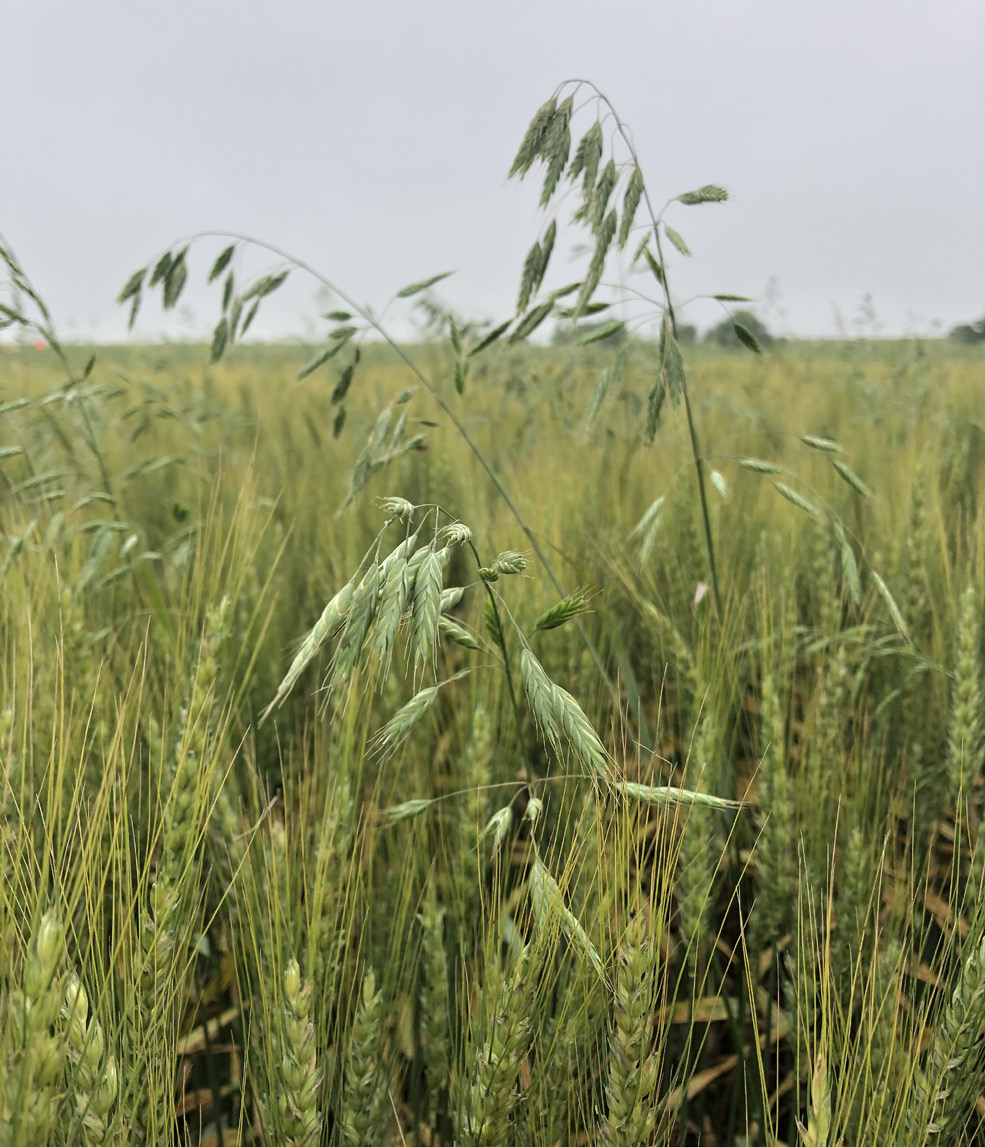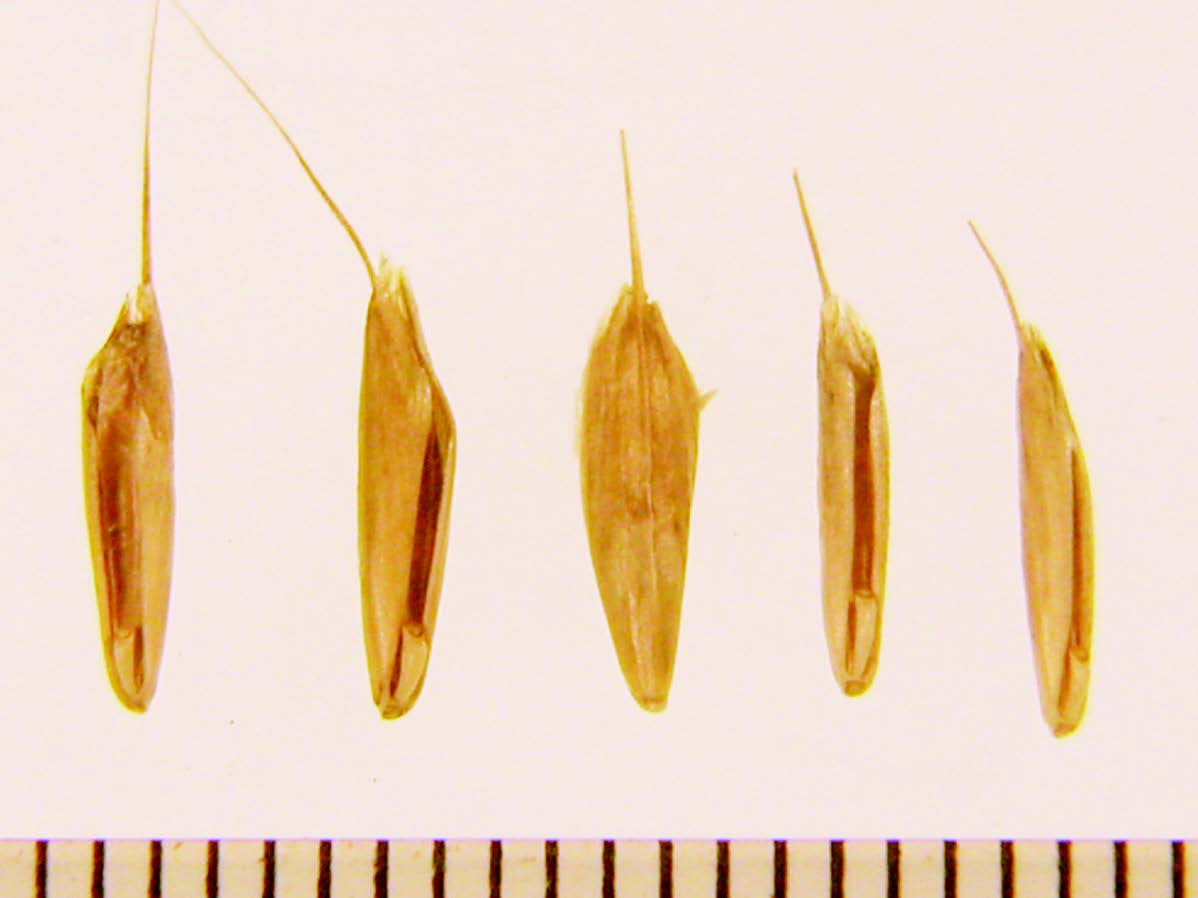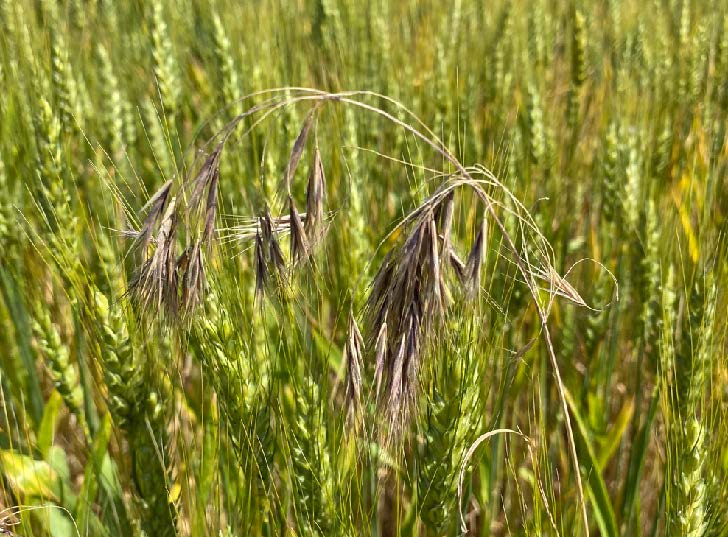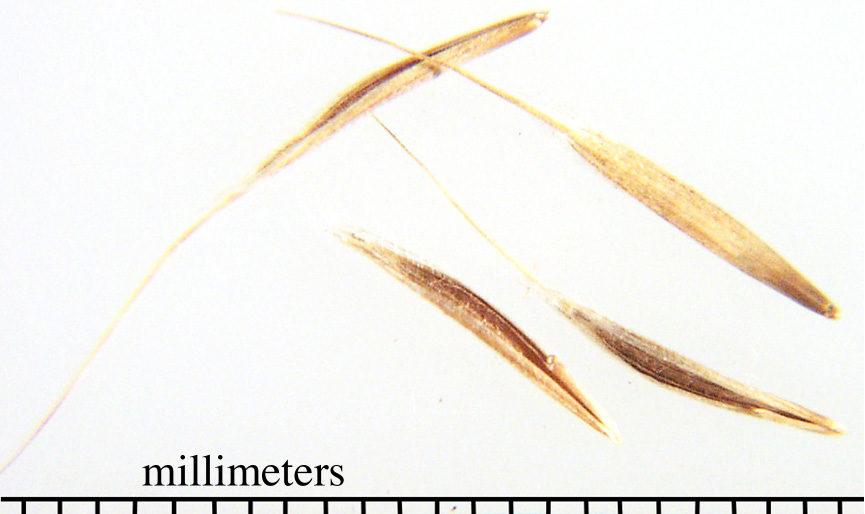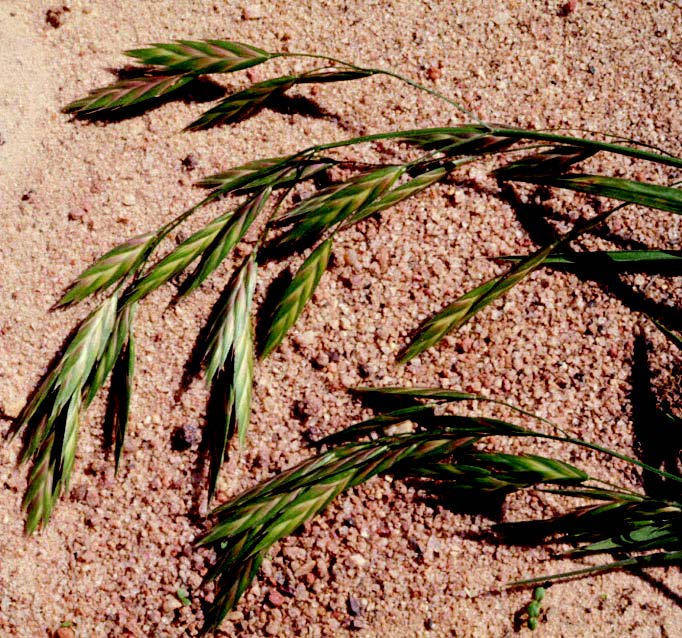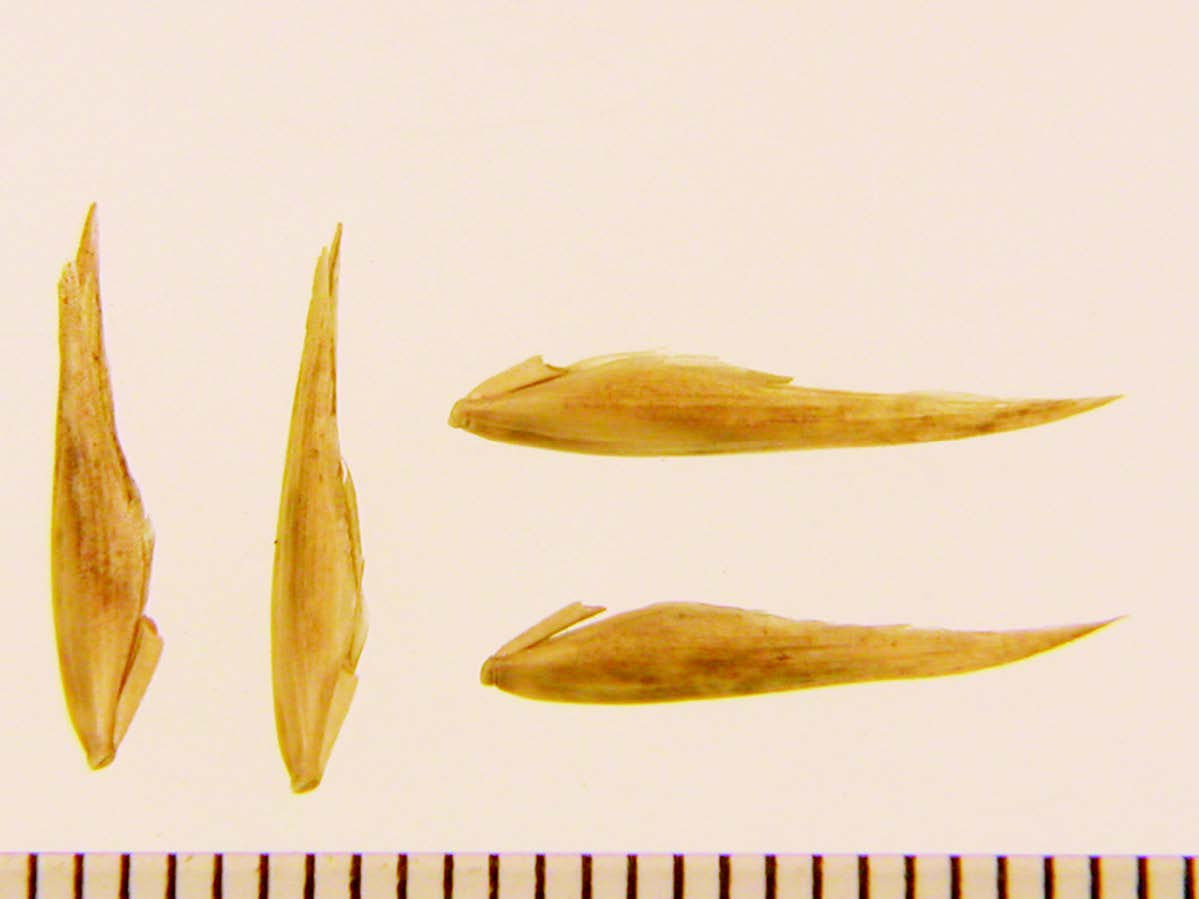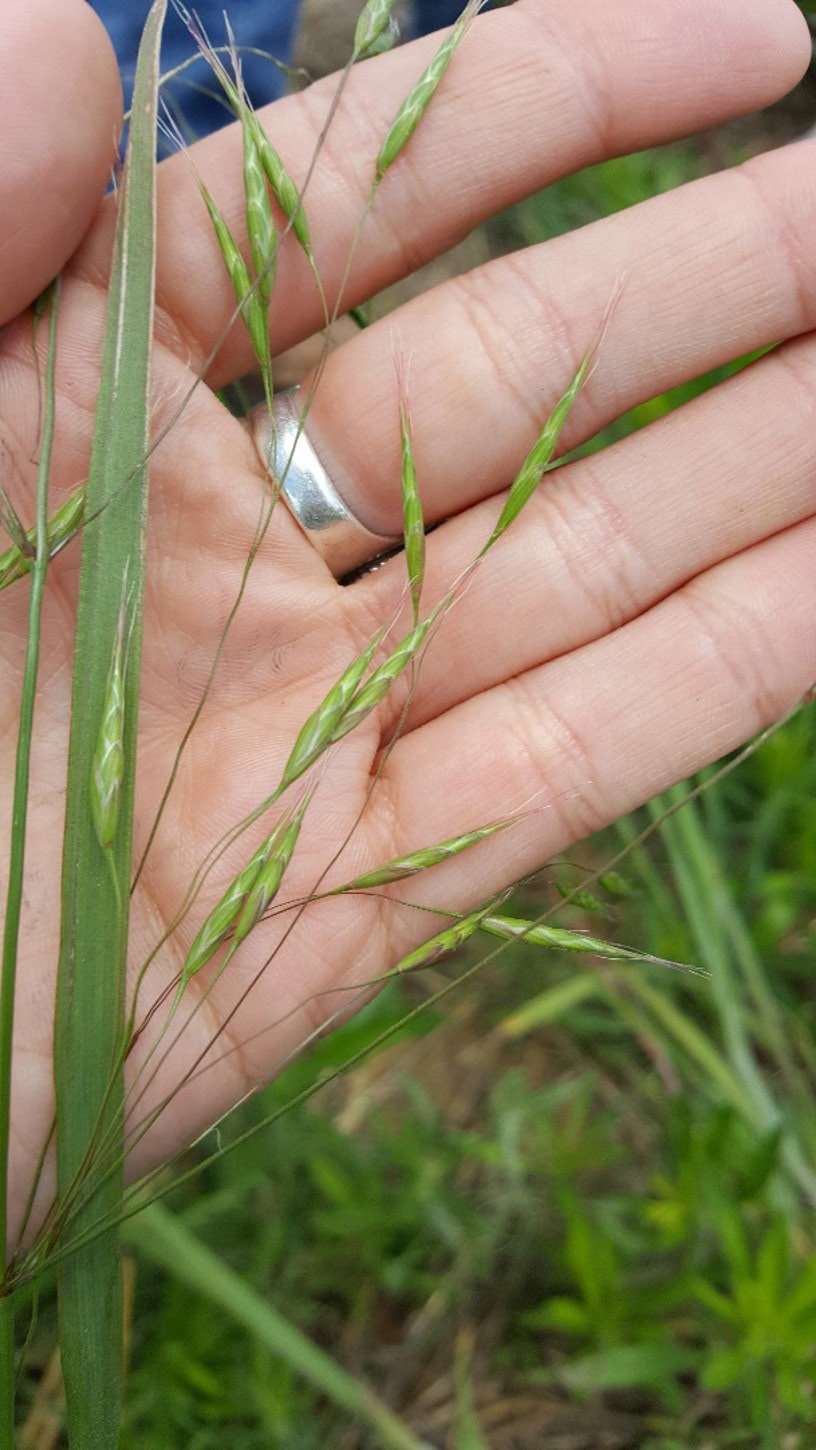True Cheat Control in Oklahoma Winter Wheat
True cheat (Bromus secalinus) (Figure 1) is a winter annual bromegrass common to most Oklahoma winter wheat producers. This serious weed problem in winter wheat impacts the crop through competition and harvesting losses, and dockage losses occur when true cheat seed is marketed with grain. This weed is troublesome due to its similar growth cycle and response to typical wheat management practices. True cheat germinates in the fall, from late August through mid-November. It increases its reproductive tillers as it grows vegetatively through the fall and winter months, initiates its reproductive growth in mid-March, flowers and sets seed in May and matures in early June. True cheat is the most common brome weed in Oklahoma, but there are other similar Bromus species in the state including downy brome (Bromus tectorum), Japanese brome (Bromus japonicus) (Figure 2) and rescuegrass (Bromus catharticus) (Figure 3).
Figure 1. Cheat (Bromus secalinus) is a very common weed in Oklahoma wheat fields. At maturity, true cheat has short awns that distinguish it from downy brome.
Cultural and Mechanical Control Practices
Cultural practices that encourage vigorous winter wheat will help the crop gain a competitive advantage over true cheat and other weeds. True cheat and wheat respond similarly to many management practices, but the following cultural and mechanical practices should be considered for minimizing the impact of true cheat.
Prevention is the best recommendation for controlling any weed in any crop, but especially for true cheat in winter wheat. Although proper equipment cleanup and other cultural control practices may take time and discipline to conduct, the alternatives for controlling true cheat are costly and/or troublesome. Control true cheat plants growing along borders, fence rows and roadsides before they produce seed that spreads into the field. Prevent plants from producing seed during the fallow season or after graze-out. Do not feed true cheat-contaminated hay to cattle that are on or will soon move to wheat pasture, since true cheat seeds remain viable after passing through the digestive tracts of cattle. Clean all tillage, planting, fertilizer and harvesting equipment prior to entering fields. Young seedling weeds can be transplanted into new fields on tillage equipment; true cheat seeds are notorious for hiding in small of harvesting equipment. Insist custom harvesters clean their combines before entering the field.
Figure 2. Downy brome (Bromus tectorum) seed have long distinct awns.
Figure 3. Rescuegrass (Bromus catharticus) seed are large than true cheat and downy brome and lack awns. (Photo by Dr. Don Murray, Regents Prof. of Weed Science, OSU).
Figure 4. Japanese brome: open, nodding panicle with long, bent awns and a floret similar to true cheat.
Proper land preparation is an important factor in the successful production of any crop. A moist, clod-free seedbed is critical for timely and uniform emergence of a competitive wheat stand. Control emerged weeds before seeding the crop. Control options before the wheat crop is established are usually cheaper than in-season control alternatives. These control options generally include tillage or the application of a broad-spectrum, postemergence herbicide such as glyphosate.
Good soil fertility management and optimum soil pH levels for wheat production increase the ability of wheat to compete with true cheat. Proper seedbed preparation does not adequately control true cheat in early planted wheat since true cheat may germinate as late as December after the crop is drilled.
Plant true cheat-free wheat seed to prevent the spread or reinfestation of true cheat into fields. Buying certified seed or cleaning wheat seed prior to planting may slightly increase seed cost, but the long-term cost of in-season true cheat control options is greater.
Table 1. Wheat yield and percent yield loss from true cheat competition of selected wheat varieties. The data are averaged over eight locations and three growing seasons. The average true cheat population was 16 plants per square foot for Greenhammer and Showdown varieties and 25 plants per square foot for all other varieties.
| Variety | Wheat yield without cheat |
Wheat yield with cheat |
Yield loss from cheat |
|---|---|---|---|
| bushels/acre | bushels/acre | ——%—— | |
| Greenhammer | 64.0 | 53.8 | 16 |
| Showdown | 67.2 | 61.2 | 9 |
| Jagger | 62.8 | 42.6 | 32 |
| Agseco 7853 | 62.0 | 36.0 | 42 |
| Triumph 64 | 47.6 | 33.9 | 29 |
| Karl 92 | 45.5 | 32.9 | 28 |
| Longhorn | 50.9 | 32.3 | 37 |
| 2180 | 45.8 | 30.6 | 33 |
| TAM 202 | 58.3 | 30.6 | 48 |
| 2163 | 52.3 | 29.6 | 43 |
| TAM 107 | 44.4 | 25.5 | 43 |
Increasing wheat seeding rate from 60 pounds per acre up to 120 pounds per acre can increase the competitive ability of wheat and reduce yield loss from true cheat. Combining increased seeding rate with narrower row spacing improves wheat’s competitiveness. These practices may increase the production cost of the crop, but should result in increased grain production as well as true cheat suppression.
Planting a competitive wheat variety can reduce yield loss from true cheat competition. Many years ago, the competitiveness of nine wheat varieties grown in Oklahoma was evaluated over a three-year period by the Oklahoma State University Small Grains Weed Control Program. More recently, two recently released varieties were assessed during the 2019-20 and 2020-21 growing seasons (Table 1). These varieties differ in their ability to compete with true cheat. Adopting this important trait when selecting a wheat variety can improve the effectiveness of other control practices. Although wheat yield and yield loss from true cheat fluctuate due to environmental conditions, the suppressive characteristics of competitive varieties toward true cheat generally fluctuate in a similar manner. There are certain characteristics that increase the competitive ability of a variety such as, rapid emergence in the fall, early accumulation of biomass and moderate height at maturity.
Delaying wheat planting until true cheat germinates, then destroying it with tillage or a broad-spectrum herbicide can effectively control early true cheat flushes. This works well in cool, wet falls, which stimulates early true cheat germination. This practice does not work in a dry fall or in a graze-out program. A delay in wheat planting will not completely control true cheat, but it reduces infestation levels and true cheat competitiveness in the fall and winter months. Since the life cycles of true cheat and wheat are similar, wheat’s competitiveness also can be reduced during the fall and winter months. If forage production for winter wheat pasture is needed, a delayed wheat planting is not recommended.
Table 2. True cheat seedheads per 10 square feet in the wheat crop after one crop rotation cycle. The crop rotations were continuous wheat, wheat followed by double-crop sorghum followed by soybean, or wheat followed by double-crop soybean followed by soybean, with the final crop being wheat for all crop rotations. Percent true cheat seedhead reduction is based on the number of seedheads in the no-tillage, no-herbicide, continuous wheat treatment (i.e. 263 seedheads per 10 square feet). Herbicides used in the continuous wheat rotation were only applied during the first year. True cheat seedhead reduction was evaluated prior to harvest for the application year and the following growing season (value in parentheses). These data are averaged over three locations.
| Crop rotation Herbicide treatment or graze out program | Seedhead reduction due to No tillage |
Seedhead reduction due to Conventional tillagea | |
|---|---|---|---|
| Continuous wheat | % Reduction | % Reduction | |
| Metribuzin 75 DF (fall application) | 88b (26)c | 96 (7) | |
| Outriderd | 98 (33) | 99 (84) | |
| Graze out | 64 (11) | 84 (85) | |
| No herbicide and no graze out | 71 (0) | 87 (44) | |
| Wheat-sorghum-soybean rotation | |||
| Average of rotational row-crop herbicides | 94 | 75 | |
| No rotational row-crop herbicide applied | 97 | 89 | |
| Wheat-soybean-soybean rotation | |||
| Average of rotational row-crop herbicides | 96 | 63 | |
| No rotational row-crop herbicide applied | 93 | 47 |
- Moldboard plowing and field cultivating were used to prepare the first year’s seedbed. Chisel plowing and field cultivating were used between the first and second year’s crops. Chisel plowing minimizes the amount of true cheat seed returned to the soil surface after moldboard plowing.
- Evaluated prior to harvest of first wheat crop.
- Evaluated prior to harvest of second wheat crop, however, herbicides were only applied the first year.
- Average of three Outrider® treatments; fall applied, spring applied and spring applied with 2,4-D. The range for the Outrider® treatments in the no tillage systems was 95% to 99% prior to harvest of the first wheat crop and 31% to 36% prior to harvest of the second wheat crop. The range for the Outrider treatments in the conventional tillage systems was 98% to 100% prior to harvest of the first wheat crop and 73% to 91% prior to harvest of the second wheat crop.
Graze-out programs reduce true cheat seed production, but only at the loss of the grain crop. In a typical graze-out program, wheat producers plant during the early fall to ensure maximum forage production and graze through the fall, winter and spring months—well beyond the hollow stem stage of wheat and true cheat. Once the cattle are removed, the wheat field should be sprayed with a broad-spectrum herbicide to ensure the remaining wheat and true cheat do not reproduce and set seed for future infestations. Tillage alone often does not destroy true cheat plants soon enough to prevent seed production. The OSU Small Grains Weed Science Program reported an 85% decline in true cheat reproductive structures in conventionally tilled, continuous wheat, graze-out systems (Table 2).
Burning stubble after wheat harvest can destroy viable true cheat seed that adds to the soil seedbank the following year. Fire reduces or eliminates the standing stubble and sterilizes the viable weed seed; however, if the fire is not hot enough, the seeds may not be sterilized and true cheat stands the following fall could go unchanged. The OSU Small Grains Weed Science Program conducted a survey of 20 wheat fields in Alfalfa, Garfield and Kingfisher counties in 1998 and 1999 to determine the impact of stubble burning on true cheat infestations the following year. Eight fields had lower true cheat infestations the following year, six fields had higher infestations and six fields showed no change. Therefore, burning does not provide a consistent method for reducing true cheat and eliminates the ground cover and surface organic matter that is beneficial for reducing soil erosion, conserving soil moisture and improving soil tilth.
Deep plowing can effectively bury true cheat seed if the surface soil is completely inverted. Some of the newer plows only turn the furrow on edge, and secondary tillage scatters the seed throughout the top of the plow layer. For deep plowing to be effective, it must be the first tillage after harvest, and 6 to 9 inches deep. It is important that the deep tillage event buries the seed and is followed by shallow tillage so as not to work the seeds back to the surface. True cheat seeds that are buried 6 to 9 inches deep will either decompose or germinate but not emerge. The OSU Small Grains Weed Science Program reduced true cheat seed-head production by 44% the year following a deep plow operation (Table 2). Although deep plowing reduces true cheat infestations, soil conservation requirements and costs should be considered.
Crop rotation increases true cheat control alternatives dramatically. True cheat control is excellent when conventional tillage in the spring is used to prepare the summer seedbed. If a no-till system is preferred, broad-spectrum burndown herbicides (eg. glyphosate) are effective at killing true cheat prior to planting. Although crop rotations are effective for controlling one sone season of true cheat, other control measures should be taken to protect against potential infestations that may arise from the abundant soil seedbank. Some of the more popular summer crops that are used for crop rotations are mungbean, soybean, cotton, sesame, corn and grain sorghum. The OSU Small Grains Weed Science Program reported at least 92% fewer true cheat reproductive structures using no-till summer crop rotations (Table 2). These crops can be profitable alternatives to producing winter wheat; however, due to the marginal summer precipitation patterns in western Oklahoma, careful planning should precede the planting of any summer crop. Winter canola also is an option as a rotational crop to clean up true cheat, because several herbicides labeled for use in winter canola, including glyphosate, Assure II®, Poast ®and Select® are highly effective against true cheat.
Herbicide Options for ALS Resistant Populations
The only herbicide that is labeled for use in wheat that is effective on ALS resistant populations (confirmed in Kay and Garfield Counties) is Aggressor® herbicide. Aggressor® is labeled for use only in CoAXium® wheat (quizalofop-P-ethyl tolerant) varieties. It will kill all other varieties. Aggressor® can be applied to actively growing wheat that contains the AXigen® (AX) trait after wheat is four-leaf but before jointing. Applications of Aggressor® must include a surfactant. Generally, a nonionic surfactant (0.25 % vol/vol) is recommended in the fall and a methylated seed oil (MSO – 1% vol/vol) is recommended in the spring. If another herbicide is tank mixed with Aggressor®, select adjuvant(s) approved for use of both products. Aggressor® CANNOT be tank mixed with dimethyl amine formulations of 2,4-D or MCPA as they are antagonistic and will result in reduced grass weed control. Consult the label for more details on surfactant and tank-mix recommendations.
Herbicide Options for ALS-Susceptible Populations
Several herbicides selectively kill ALS susceptible true cheat when applied postemergence (after true cheat and/or wheat have emerged) with minimal, if any, injury to the wheat. In addition to these herbicides, Amber®, Finesse® and Metribuzin 75 DF are labeled for cheat suppression in wheat but are not recommended because of their variable efficacy and/or potential for crop injury. Always read and follow the pesticide label to ensure safety to the handler, applicator and the crop.
Beyond® herbicide is labeled for use only on Clearfield® and Clearfield® Plus wheat (imidazolinone tolerant) varieties. It will kill all other varieties. Beyond® can be applied to Clearfield® wheat that is beginning to tiller, but prior to jointing and to emerged, actively growing cheat with no more than five leaves. It is most effective on cheat if applied in the fall to small (two to five leaves), actively growing cheat plants; however, it is labeled for spring applications as well.
Applications of Beyond® must include an adjuvant and nitrogen source. For Clearfield® Systems, use a nonionic surfactant (NIS) at 0.25% vol/vol and a nitrogen fertilizer solution ( 2.5% vol/vol once tiller initiation has begun. For Clearfield® Plus Systems, crop oil concentrate or methylated seed oil at 102% vol/vol) can by used in place of NIS at tiller initiation. In Cleaffield® Plus Systems, applications can be made as early as the two-leaf stage but can only include NIS. Liquid nitrogen (UAN) cannot be used as the sole carrier when applying Beyond®; however, UAN can be used for up to 50% of the carrier volume. Do not apply more than 8 fluid ounces per acre of Beyond® during the growing season. Wheat cannot be harvested for grain within 60 days following a Beyond® application. Beyond® can be tank mixed with 2,4-D, bromoxynil, dicamba or MCPA. See the label for specific tank-mix recommendations and plant back restrictions.
Everest® 3.0 herbicide is labeled for postemergence applications after wheat has a minimum of one-leaf, but before the four-leaf stage. Everest® is most effective on true cheat if applied in the fall to small (one- to four-leaf), actively growing plants; however, it is labeled for spring applications as well.
Water or liquid nitrogen (UAN) can be used as the carrier when applying Everest®. UAN can only be used as the carrier if the spray solution contains less than 50% liquid nitrogen and if the application will not exceed more than 30 pounds of actual nitrogen per acre, otherwise severe leaf burn may reduce forage production and cheat control. When using UAN as the carrier, include 0.25% vol/vol non-ionic surfactant. When using water as the carrier, include 0.25 to 0.50% vol/vol nonionic surfactant. Everest® can only be applied once during a wheat crop (Table 3) and wheat can be grazed immediately after application. Everest® can be tank mixed with 2,4-D Ester, bromoxynil, MCPA Ester and sulfonylurea herbicides when water is the carrier. Observe the growth stage restrictions on using these herbicides.
Table 3. Application information and restrictions of true cheat control herbicides for use in Oklahoma winter wheat.
| Herbicide | Appl. Timea | Expected Result | Additive | Carrier | Grazing Restriction |
|---|---|---|---|---|---|
| Aggressor® | POST | excellent control | 1/8% to 1/4% NIS | at least 50% water | none |
| Beyond® | POST | excellent control | 1/8% to 1/4% NIS | at least 50% water | none |
| Everest® 3.0 AG | POST | excellent control | 1/4% to 1/2% NIS | water or UAN | none |
| Outrider® | POST | excellent control | 1/4% to 1/2% NIS | water or UAN | none |
| Olympus® | POST | excellent control | 1/4% to 1/2% NIS | up to 50% UAN | none |
| PowerFlex HL® | POST | excellent control | 1/4% to 1/2% NIS | up to 50% UAN | 7 days |
| Amber® + Metribuzin | POST | fair to good control | 1/4% to 1/2% NIS | water | 14 days |
| Finesse® + Metribuzin | POST | fair to good control | 1/8% to 1/2% NIS | water | 14 days |
a POST treatments are most effective when applied at the one- to four-leaf stage.
Wheat may be replanted immediately after an application of Everest®. STS-soybean may be replanted after six months. Canola, soybean and sunflower may be replanted after nine months and corn may be replanted after 11 months. Everest® is degraded by soil microbes; therefore, environmental conditions that decrease microbial activity should be considered when making rotational cropping decisions. Drought and/or cold temperatures, as well as soils with less than 2% organic matter may reduce Everest® degradation. If these conditions exist, a soil bioassay may be necessary to ensure safety for rotational crops.
Outrider® is labeled for preemergence and postemergence applications in wheat to selectively control several winter annual grasses including true cheat. Outrider® is most effective for controlling true cheat and maximizing wheat yield if applied in the fall to small, (two-leaf to five-tiller) actively growing true cheat plants (Figure 4); however, the products are labeled for spring applications as well.
Water or liquid nitrogen (UAN) can be used as the carrier when applying Outrider®. Only use UAN solutions that contain less than 50% liquid nitrogen as carriers and do not exceed more than 30 pounds of actual nitrogen per acre, as severe leaf burn may reduce forage production and true cheat control. Regardless of carrier, always include a nonionic surfactant in the spray solution (0.25% vol/vol with a UAN carrier, or 0.50% vol/vol with a water carrier). Never use a UAN solution or a nonionic surfactant that lowers the spray pH below 5. Outrider® can only be applied once during a wheat growing season (Table 3). These products can be tank mixed with 2,4-D Ester, bromoxynil and MCPA Ester herbicides. however, there may be a decrease in true cheat control if a tank mix partner is used.
Outrider® does not have grazing restrictions; however, wheat cannot be harvested for hay within 30 days after application or for grain within 55 days after application. Following an application of Outrider®, there is a rotation restriction of three months with 18 inches of cumulative precipitation before planting STS-soybean. For cotton, there is a rotation restriction of 12 months and 30 inches of precipitation. The plant back restriction for corn, grain sorghum and sunflower is 22 months with 30 inches of cumulative precipitation. For fields with a soil pH greater than 6.0, a field bioassay must be conducted before planting sunflower to ensure crop safety. Wheat may be replanted at any time after an application of Outrider®.
Olympus® is labeled for postemergence applications for control of several broadleaf and grass weeds, including true cheat. Olympus® can be applied from one-leaf wheat up to jointing and is most effective when applied in the fall. Applications must include a non-ionic surfactant at 0.25 to 0.50% vol/vol. Olympus® can be applied with up to 50% liquid nitrogen (UAN) as the carrier, but the application should not include more than 30 pounds of actual nitrogen per acre. Olympus® can be tank mixed with several products for postemergence weed control in wheat. Check individual product labels to determine the appropriate rates, adjuvants and application timings.
There is a restriction of 12 months and 24 inches of precipitation between application of Olympus and planting of non-STS soybean, sorghum and sunflower. STS-soybean may be planted after four months and 10 inches of precipitation. Corn requires an 18-month wait and 30 inches of cumulative precipitation. Wheat can be replanted immediately in case of crop failure.
PowerFlex HL® is another option for postemergence cheat control in wheat and may be applied from the three-leaf wheat growth stage up to jointing. The best results are obtained when grass weeds are treated at the two-leaf to two-tiller growth stage and are actively growing. When PowerFlex® is applied alone, spray solutions should include a non-ionic surfactant at 0.25 to 0.50% vol/vol and spray grade liquid nitrogen fertilizer at 1 quart to 2 quarts per acre or ammonium sulfate fertilizer at 1.5 pounds to 3 pounds per acre. Applications can be made with up to 50% liquid nitrogen (UAN) as the carrier, but the application should not include more than 30 pounds of actual nitrogen per acre. PowerFlex® can be tank mixed with other products labeled for postemergence application in winter wheat; however, PowerFlex® should not be mixed with products containing dicamba or amine formulations of 2,4-D or MCPA, as these combinations may result in reduced grass control.
PowerFlex® has a three-month rotation restriction to soybean and nine-month rotation restriction to canola, corn, grain sorghum and sunflower.

